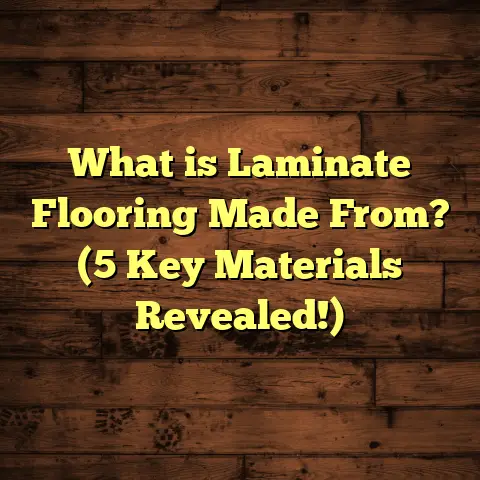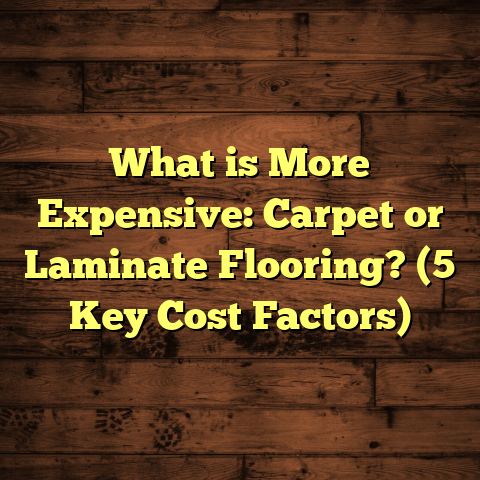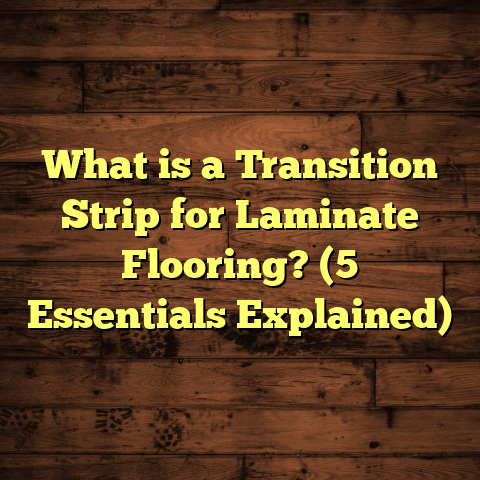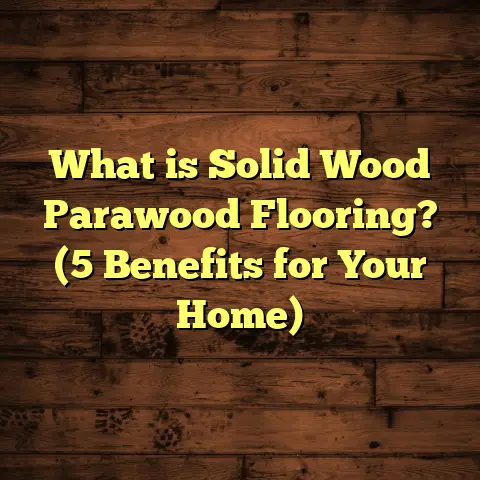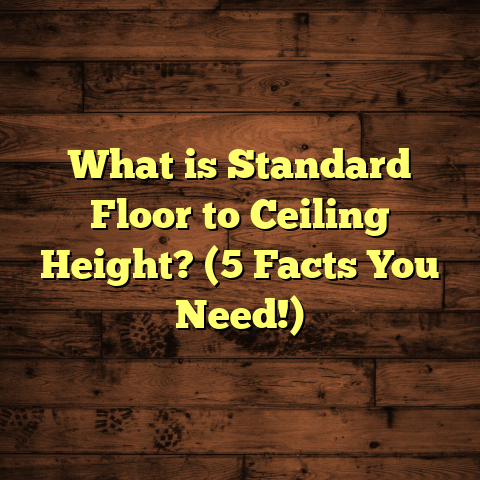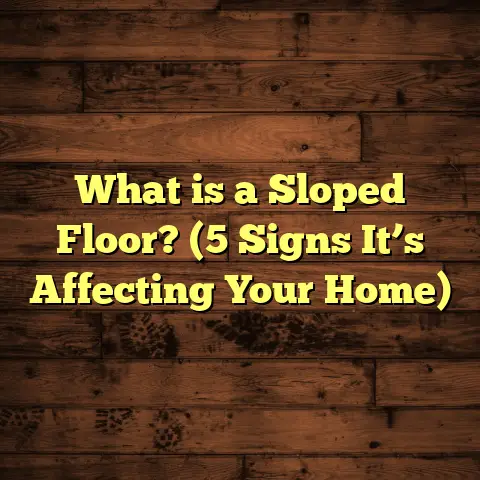What is LVT Flooring? (5 Benefits You Didn’t Know About)
I remember the first time I stepped into a home with LVT flooring. It was a bustling family house where kids were running around, dogs were chasing balls, and the whole space had a warm, inviting vibe. The floor looked like real hardwood, but felt softer underfoot and noticeably warmer than tile or stone. That moment sparked my curiosity about LVT flooring—what it really is, how it performs, and why it’s become such a popular choice for homeowners and commercial spaces alike.
Over the years, I’ve worked on countless flooring projects featuring LVT. I’ve seen it shine in high-traffic areas, struggle a little in unexpected ways, and consistently impress clients with its blend of style and function. Today, I want to share everything I know about LVT flooring—its benefits, some of its challenges, and interesting facts you might not have heard before.
What is LVT Flooring?
LVT stands for Luxury Vinyl Tile. At its simplest, it’s a type of vinyl flooring that offers superior aesthetics and durability compared to traditional vinyl. But let’s unpack that a bit.
Unlike sheet vinyl or older vinyl floors that can look flat and plastic-like, LVT is engineered to replicate natural materials such as wood, stone, or ceramic tile. It does this through advanced printing techniques combined with texture embossing. So when you run your hand across an LVT plank that mimics oak wood, you don’t just see wood grain—you can feel it too.
How is LVT Made?
LVT is made up of several layers stacked together:
- Backing layer: This bottom layer adds stability and moisture resistance.
- Core layer: Often made from PVC or a composite material, it provides strength and flexibility.
- Printed design layer: This is where the magic happens—a high-resolution image of wood grain, stone veins, or tile patterns.
- Wear layer: A clear protective layer on top that prevents scratches, stains, and wear from foot traffic.
The thickness of these layers varies based on the intended use—residential or commercial—with commercial-grade LVT having thicker wear layers for added durability.
Types of LVT
There are generally three types of LVT installation methods:
- Glue-down: Requires adhesive to attach the tiles or planks firmly to the subfloor.
- Click-lock (floating): Interlocking planks that snap together without glue.
- Peel-and-stick: Backed with adhesive for DIY-friendly installation.
Each has pros and cons depending on your project’s needs. For example, click-lock is great for quick installations or over existing floors, while glue-down offers more stability in heavy-use areas.
My Early Experience with LVT: Successes and Challenges
When I first started recommending LVT to clients, I was drawn by its promise of combining beauty with resilience. One early project involved a family who wanted to replace their worn-out laminate flooring in a busy kitchen and dining area. They loved the look of hardwood but worried about water damage from spills.
After discussing options, we chose a waterproof glue-down LVT with textured oak design. The installation went smoothly over the existing subfloor after some leveling prep work. The family loved the result—they had the wood look they wanted without the maintenance headaches. The floor handled daily spills and heavy foot traffic without any issues for over three years.
But not everything was perfect. In another case, I helped install peel-and-stick LVT in an apartment with lots of natural light streaming through large windows. After about two years, the sections near the windows showed slight discoloration and lifting at the edges. This was due to UV exposure and some heat buildup under direct sun—something I hadn’t fully anticipated.
From that experience, I learned how important it is to choose the right product for your specific environment and to educate clients about potential limitations.
The Five Benefits of LVT Flooring You Probably Didn’t Know
Everyone talks about LVT being durable or waterproof. But there’s so much more beneath the surface that makes it such a great option. Here are five benefits based on my experience and research that might surprise you.
1. It’s Surprisingly Comfortable and Quiet
When people think of vinyl flooring, they often imagine something hard and noisy underfoot. But luxury vinyl tile offers a different experience because of its layered construction. The core layer adds a little cushioning, making it softer than stone or ceramic tile yet still firm enough to feel stable.
I remember installing LVT in a multilevel condo where noise transfer between floors was a big concern. After installation, residents reported much less footstep noise compared to previous ceramic tile floors. This makes LVT ideal for apartments or homes where sound dampening matters.
Also, compared to hardwood or laminate—which can creak or echo—LVT absorbs sound better. Running toys or dropping items on it doesn’t produce that hollow “clack” sound you get on other floors.
2. Waterproofing That’s Actually Reliable
You hear waterproof claims often these days, but not all floors live up to them equally. LVT’s waterproof nature comes from its vinyl core and protective wear layer forming an impermeable barrier against moisture.
This makes it excellent for kitchens, bathrooms, laundry rooms, mudrooms—anywhere prone to spills or humidity. For example, one client with an active household installed waterproof LVT in their basement family room. During a heavy rainstorm that caused minor flooding upstairs, their basement floor stayed perfectly intact with no warping or staining.
Even better: certain commercial-grade LVT products are engineered with enhanced waterproof cores so they won’t swell or warp even if submerged briefly. This durability is hard to match with hardwood or laminate flooring.
3. Endless Design Options Beyond Wood
Wood-look floors dominate the market, but LVT comes in so many styles you can customize your space creatively without splurging on natural stone or tile.
I once worked on a restaurant project where we used multiple tile-look LVT patterns arranged in an eye-catching mosaic layout across the dining room floor. Achieving that look with real tiles would have added thousands to the budget—and taken weeks longer to install.
There are also options mimicking marble veining, slate textures, concrete finishes, even metallic accents. If you want a modern industrial vibe or classic elegance without paying premium prices or worrying about brittle stone cracking, LVT’s design flexibility is a big win.
4. Fast Installation Means Less Disruption
I’ve been on jobs where flooring installation dragged out for days or weeks because of complex prep work or drying times for adhesives. With LVT—especially click-lock systems—you can often complete installations within one or two days depending on room size.
This speed is great for busy homeowners who need minimal disruption or commercial properties that want to reopen quickly after renovations.
One memorable project involved replacing worn-out carpet in an office lobby overnight using floating LVT planks glued down only at edges for extra hold. The client was amazed they could have brand-new flooring ready for business by morning with no mess or lingering odors.
And if you’re working on a budget without time for extensive demolition? Some peel-and-stick options allow you to install directly over existing floors if they’re smooth enough—saving money on removal and disposal costs.
5. Durability That Holds Up Under Pressure
LVT’s wear layer protects against scratches and dents better than laminate or hardwood in many cases—especially when pets and kids come into play.
One retail shop I worked with installed commercial-grade LVT in their showroom where customers frequently dragged carts, equipment was moved daily, and foot traffic was constant. A year later, despite heavy usage and occasional drops of metal tools, the floor looked almost brand new.
That kind of resilience means fewer repairs or replacements over time compared to more delicate materials—and that adds up financially for homeowners and businesses alike.
Challenges I’ve Encountered with LVT Flooring
While I’m a fan of LVT’s many benefits, it wouldn’t be honest not to share some challenges I’ve faced during installations or post-installation issues:
Subfloor Quality Is Critical
LVT can’t fix problems underneath it. If your subfloor isn’t level or has bumps/cracks, those imperfections will show through the vinyl tiles or planks over time.
In one case, I installed click-lock LVT over an uneven plywood floor in an older home without proper leveling first. Within months, some planks popped loose because the subfloor flexed too much underneath weight—a frustrating outcome avoided by better prep work upfront.
UV Exposure Can Cause Fading
Not all LVT products have UV-resistant coatings. In spaces flooded with sunlight through large windows or skylights, some floors develop fading or yellowing over several years.
I’ve seen this happen in sunny sunrooms where owners didn’t use window treatments initially. Choosing UV-resistant flooring options can reduce this risk substantially.
Temperature Fluctuations May Affect Expansion
Extreme temperature changes can cause vinyl materials like LVT to expand or contract slightly. In areas like sun-drenched porches or unconditioned garages converted into living spaces, this movement can cause edges to curl or gaps between planks to widen.
Proper acclimation before installation and leaving expansion gaps around room perimeters helps mitigate this problem.
Repairs Can Be Tricky
If one plank gets damaged—say by sharp furniture legs—it’s not always simple to replace just that piece unless you used floating click-lock systems designed for easy removal.
Glue-down installations often require removing larger sections because tiles are bonded permanently to the floor below.
Deep Dive into Data & Research on LVT Flooring
To give you an idea of how well LVT performs overall compared to other flooring options, here are some useful statistics from industry studies:
- According to the Freedonia Group report (2023), vinyl flooring sales—including LVT—grew by about 12% annually over the last five years in North America.
- A 2022 survey by HomeAdvisor found that 82% of homeowners who installed vinyl plank flooring were satisfied with its durability after three years.
- Wear layer thickness is crucial: residential wear layers typically range from 6 mil (light use) up to 12 mil (heavy use), while commercial-grade can exceed 20 mil for extreme durability.
- In terms of cost-effectiveness: while hardwood flooring averages $8-$14 per square foot installed, mid-range LVT typically costs $3-$7 per square foot—making it attractive for budget-conscious projects.
- Waterproofing tests show some commercial waterproof LVT cores can remain dimensionally stable after 72 hours submerged in water without delamination—a key advantage over engineered hardwood.
How FloorTally Has Made My Life Easier
I want to share how I handle cost estimation during my projects because getting that right saves headaches later on.
Estimating flooring costs involves more than just price per square foot for material; labor rates vary by region, waste factor must be accounted for due to cuts/spills/damage during install, and additional supplies like adhesives add up too.
FloorTally has been instrumental here—it lets me plug in local labor rates alongside different material choices and installation types so I get accurate total cost numbers quickly. It even factors in waste percentages automatically based on room shape complexity.
This tool has saved me hours compared to manually calculating everything from different spreadsheets and supplier quotes—and my clients appreciate having transparent breakdowns so they understand exactly what they’re paying for.
Using FloorTally means fewer surprises during budgeting stages—and that peace of mind helps everyone involved feel confident moving forward with projects.
More Stories from My Flooring Journeys
Let me share a couple more stories illustrating how versatile LVT can be:
A Busy Family Kitchen Revamp
A client with four kids wanted new flooring that could handle constant spills and dropped utensils but didn’t want cold tile underfoot during winter months. We chose a waterproof wood-look LVT with a soft underlayment beneath for extra comfort.
The family reported back after six months how much easier cleanup was—no staining from juice spills—and how their feet stayed warm even on chilly mornings. Plus, their dogs’ nails didn’t scratch the floor like hardwood used to.
Commercial Space With Style & Function
I worked with a boutique hotel wanting stylish floors that could withstand luggage wheels rolling around daily while matching their modern aesthetic.
We mixed stone-look LVT tiles in common areas with wood-look planks in guest rooms—both glue-down for maximum stability. The hotel manager was thrilled with how quickly installation finished between guest stays and how little maintenance the flooring required afterward.
What Makes LVT Stand Out Compared to Other Flooring?
You might wonder how LVT stacks up against alternatives like hardwood, laminate, ceramic tile, or carpet—so here’s my take based on practical factors:
| Flooring Type | Durability | Moisture Resistance | Comfort Underfoot | Installation Ease | Cost Range (Installed) | Maintenance |
|---|---|---|---|---|---|---|
| Hardwood | Medium-High | Low | Medium | Moderate | $8 – $14 / sq ft | Refinishing needed |
| Laminate | Medium | Low-Medium | Medium | Easy | $3 – $7 / sq ft | Sensitive to water |
| Ceramic Tile | High | High | Low | Moderate | $5 – $15 / sq ft | Grout cleaning |
| Carpet | Low-Medium | Low | High | Easy | $3 – $10 / sq ft | Regular cleaning |
| LVT Flooring | High | High | High | Easy | $2.50 – $7 / sq ft | Low maintenance |
What this shows is that LVT offers an excellent balance across many categories where other materials might sacrifice one aspect for another—for example, hardwood looks great but is vulnerable to water damage; tile handles water but feels cold; carpet feels cozy but isn’t durable in wet areas.
Tips I Share With Clients Considering LVT Flooring
If you’re thinking about installing LVT yourself or hiring someone else, here are some pointers I often give out:
- Choose your wear layer wisely: Thicker wear layers mean better protection especially if you have pets or heavy traffic.
- Prepare your subfloor carefully: Smoothness and levelness are key to prevent future issues like plank lifting.
- Consider room lighting: Use UV-resistant products if your space gets lots of direct sunlight.
- Allow acclimation time: Let boxes of LVT sit at room temperature before installation to minimize expansion issues later.
- Don’t underestimate waste factor: Order 5-10% extra material depending on room shape complexity.
- Use professional installers when possible: DIY is possible with peel-and-stick but complicated layouts benefit from experts.
- Plan your budget realistically: Factor in underlayment (for sound absorption/comfort), adhesives (if glue-down), trims/transition strips.
Wrapping It Up: Why I Recommend LVT Flooring
After working extensively with various flooring materials over many years, I can honestly say that luxury vinyl tile stands out as one of the most practical yet stylish choices available today. It offers many hidden advantages beyond what most people expect—from comfort and quietness to design versatility and reliable waterproofing.
If you want floors that look great but won’t give you headaches from damage or upkeep down the line—and if you value fast installation without sacrificing quality—LVT deserves serious attention.
Feel free to ask me anything about it! Whether you want help choosing products based on your lifestyle or need accurate cost estimates (I’ll gladly walk you through tools like FloorTally), I’m here to help make your flooring journey smoother and smarter.
Have you tried living with LVT before? What questions do you have? Let’s chat—I’ve got plenty more stories and tips up my sleeve!
